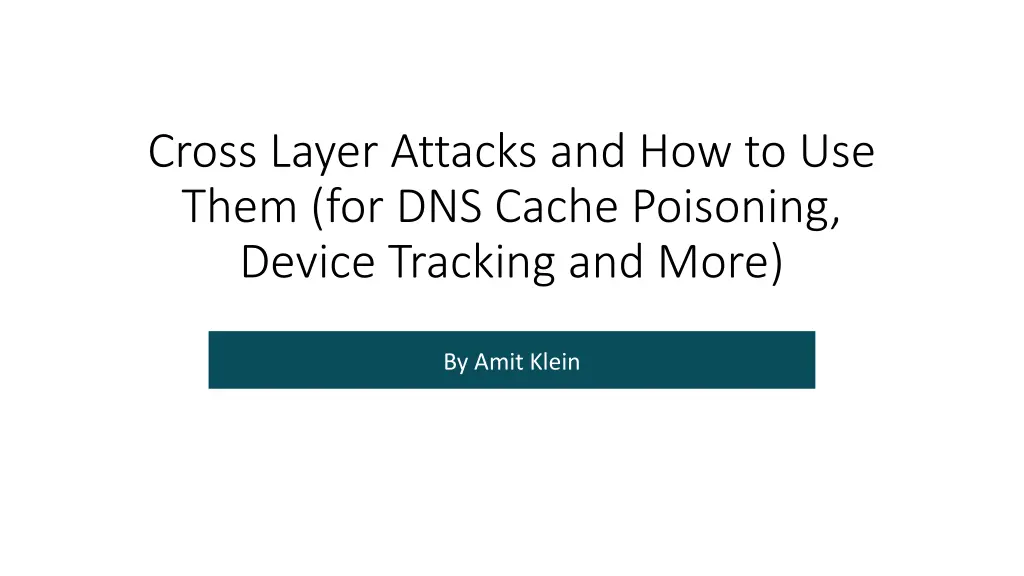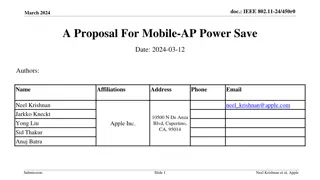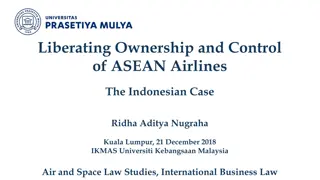
Exploiting PRNG for DNS Cache Poisoning and Cross-Layer Attacks
"Learn about DNS cache poisoning and cross-layer attacks, focusing on how exploiting the PRNG algorithm can lead to severe damage to user privacy and integrity. Understand the implications and methods to protect against such vulnerabilities."
Download Presentation

Please find below an Image/Link to download the presentation.
The content on the website is provided AS IS for your information and personal use only. It may not be sold, licensed, or shared on other websites without obtaining consent from the author. If you encounter any issues during the download, it is possible that the publisher has removed the file from their server.
You are allowed to download the files provided on this website for personal or commercial use, subject to the condition that they are used lawfully. All files are the property of their respective owners.
The content on the website is provided AS IS for your information and personal use only. It may not be sold, licensed, or shared on other websites without obtaining consent from the author.
E N D
Presentation Transcript
Cross Layer Attacks and How to Use Them (for DNS Cache Poisoning, Device Tracking and More) By Amit Klein
DNS DNS is fundamental to the way the internet works Every non-numeric URL requires the browser to resolve the host name before a TCP/IP connection to the destination host can be initiated. Therefore, if someone could find a way to attack or exploit this process, they could severely damage the user s privacy and integrity. DNS cache poisoning is one such method.
DNS Cache Poisoning User enters domain name, DNS resolver responds with the IP address associated with that domain name. To reduce the length of the resolution process, the resolver stores IP addresses related to domain names in its cache. In DNS cache poisoning, the attacker has set the IP address for a domain name to an incorrect one. DNS resolvers have no way of verifying if the association is correct or not. The poisoned cache will remain until its TTL expires.
DNS Cache Poisoning cont.. Uncached Cached
DNS Cache Poisoning cont.. The DNS protocol is implemented on top of UDP, which is a stateless protocol. In order to spoof a DNS answer, the attacker needs to know/guess all the UDP parameters in the UDP header of the genuine DNS answer. Overall the attacker needs to guess the Transaction ID (TXID) and the UDP destination port.
Pseudo Random Number Generator (PRNG) Specifically, the PRNG in use in the Linux kernel Used by the Linux Operating System as well as Android It s weak This paper s main focus is on exploiting its predictability
PRNG and Cross Layer Attacks The algorithm is used by many consumers in the Linux Kernel. The paper focuses on the invocations that are in the TCP and UDP connect() IPv6 flow label generation, the UDP source port generation and (in recent Linux kernels) the IPv4 ID generation for TCP. Because the algorithm is shared by all three consumers it allows cross layer attacks to be used against the Linux kernel.
Exploitation of PRNG for DNS Cache Poisoning Obtain partial PRNG readouts by establishing multiple TCP/IPv6 connections to the target device and observing the flow labels on the TCP packets sent by the device. Use this to extract the internal PRNG state. (Lots of maths) Remotely force the device to emit a DNS query over UDP for a host name we control. Send a burst of spoofed DNS answers (going over all possible TXID values, with the UDP port predicted from the extracted PRNG state) containing an arbitrary DNS record. This record is cached by the stub resolver, which results in DNS cache poisoning.
Exploitation of PRNG for Device Tracking HTML snippet which forces the browser running on the device to send TCP/IPv6, UDP, or TCP/IPv4 traffic to our website over multiple TCP/UDP connections. This allows us to reconstruct the internal PRNG state for a single core. Process is repeated several times to get the state for as many cores as possible. Then, compare the states that were extracted with the states of devices already recorded. If a match is found, we can assume that it is the same device as the one recorded earlier
Advantages of the Technique Our DNS cache poisoning technique is approximately 3000- 6000 times faster than a brute force attack, making it very practical in the present day Internet connection bandwidth. It works completely remotely, i.e. it does not need any malicious software installed on the target machine. Our device tracking technique works across browsers, across the browsers privacy mode, and across different networks.
Weaknesses of the attack The attack is very limited Countered by many common methods of DNS encryption such as DoT, DoH or DNSSEC Only works on linux and android devices



















